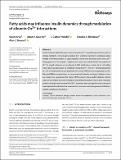Files in this item
Fatty acids may influence insulin dynamics through modulation of albumin-Zn2+ interactions
Item metadata
| dc.contributor.author | Arya, Swati | |
| dc.contributor.author | Gourley, Adam J. | |
| dc.contributor.author | Penedo , J. Carlos | |
| dc.contributor.author | Blindauer, Claudia A. | |
| dc.contributor.author | Stewart, Alan J. | |
| dc.date.accessioned | 2021-11-02T10:30:10Z | |
| dc.date.available | 2021-11-02T10:30:10Z | |
| dc.date.issued | 2021-11-21 | |
| dc.identifier | 276265438 | |
| dc.identifier | 17de77da-9da9-4f30-b041-cd7752028315 | |
| dc.identifier | 85118368278 | |
| dc.identifier | 000713460700001 | |
| dc.identifier.citation | Arya , S , Gourley , A J , Penedo , J C , Blindauer , C A & Stewart , A J 2021 , ' Fatty acids may influence insulin dynamics through modulation of albumin-Zn 2+ interactions ' , BioEssays , vol. 43 , no. 12 , 202100172 . https://doi.org/10.1002/bies.202100172 | en |
| dc.identifier.issn | 0265-9247 | |
| dc.identifier.other | ORCID: /0000-0002-5807-5385/work/102725107 | |
| dc.identifier.other | ORCID: /0000-0003-4580-1840/work/102725464 | |
| dc.identifier.other | ORCID: /0000-0001-7978-9507/work/102725796 | |
| dc.identifier.uri | https://hdl.handle.net/10023/24238 | |
| dc.description | We thank the Leverhulme Trust (grant no. RPG-2017-214), the Scottish Funding Council (through a St Andrews Restarting Research Fund award) and the Wellcome Trust (through an Institutional Strategic Support Fund award; grant no. 204821/Z/16/Z) for funding. | en |
| dc.description.abstract | Insulin is stored within the pancreas in an inactive Zn2+-bound hexameric form prior to release. Similarly, clinical insulins contain Zn2+ and form multimeric complexes. Upon release from the pancreas or upon injection, insulin only becomes active once Zn2+ disengages from the complex. In plasma and other extracellular fluids, the majority of Zn2+ is bound to human serum albumin (HSA), which plays a vital role in controlling insulin pharmacodynamics by enabling removal of Zn2+. The Zn2+-binding properties of HSA are attenuated by non-esterified fatty acids (NEFAs) also transported by HSA. Elevated NEFA concentrations are associated with obesity and type 2 diabetes. Here we present the hypothesis that higher NEFA levels in obese and/or diabetic individuals may contribute to insulin resistance and affect therapeutic insulin dose-response profiles, through modulation of HSA/Zn2+ dynamics. We envisage this novel concept to have important implications for personalised treatments and management of diabetes-related conditions in the future. | |
| dc.format.extent | 9 | |
| dc.format.extent | 847759 | |
| dc.language.iso | eng | |
| dc.relation.ispartof | BioEssays | en |
| dc.subject | Diabetes | en |
| dc.subject | Förster resonance energy transfer | en |
| dc.subject | Insulin decomplexation | en |
| dc.subject | Insulin resistance | en |
| dc.subject | Non-esterified fatty acids | en |
| dc.subject | Serum albumin | en |
| dc.subject | Zinc | en |
| dc.subject | QH301 Biology | en |
| dc.subject | RM Therapeutics. Pharmacology | en |
| dc.subject | 3rd-DAS | en |
| dc.subject | SDG 3 - Good Health and Well-being | en |
| dc.subject.lcc | QH301 | en |
| dc.subject.lcc | RM | en |
| dc.title | Fatty acids may influence insulin dynamics through modulation of albumin-Zn2+ interactions | en |
| dc.type | Journal article | en |
| dc.contributor.sponsor | Scottish Funding Council | en |
| dc.contributor.sponsor | The Wellcome Trust | en |
| dc.contributor.institution | University of St Andrews. Cellular Medicine Division | en |
| dc.contributor.institution | University of St Andrews. School of Medicine | en |
| dc.contributor.institution | University of St Andrews. Sir James Mackenzie Institute for Early Diagnosis | en |
| dc.contributor.institution | University of St Andrews. Institute of Behavioural and Neural Sciences | en |
| dc.contributor.institution | University of St Andrews. Biomedical Sciences Research Complex | en |
| dc.contributor.institution | University of St Andrews. Centre for Biophotonics | en |
| dc.contributor.institution | University of St Andrews. School of Physics and Astronomy | en |
| dc.identifier.doi | 10.1002/bies.202100172 | |
| dc.description.status | Peer reviewed | en |
| dc.identifier.grantnumber | N/A | en |
| dc.identifier.grantnumber | en |
This item appears in the following Collection(s)
Items in the St Andrews Research Repository are protected by copyright, with all rights reserved, unless otherwise indicated.

